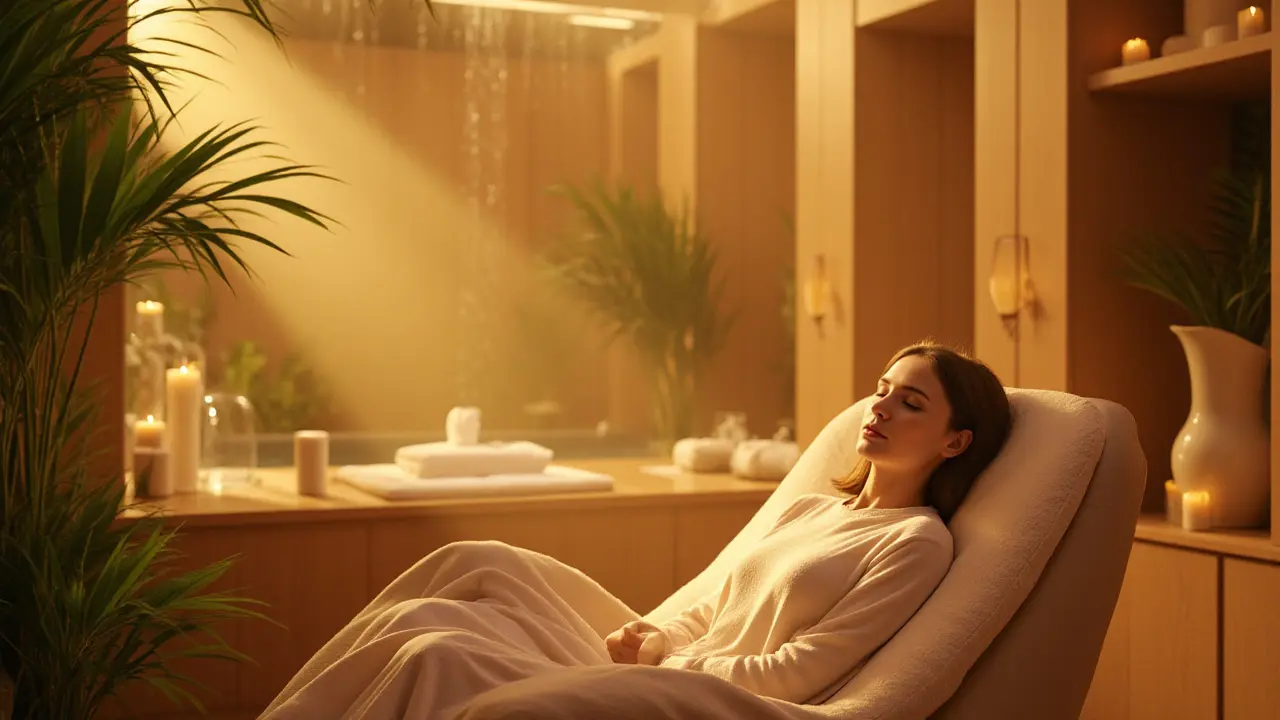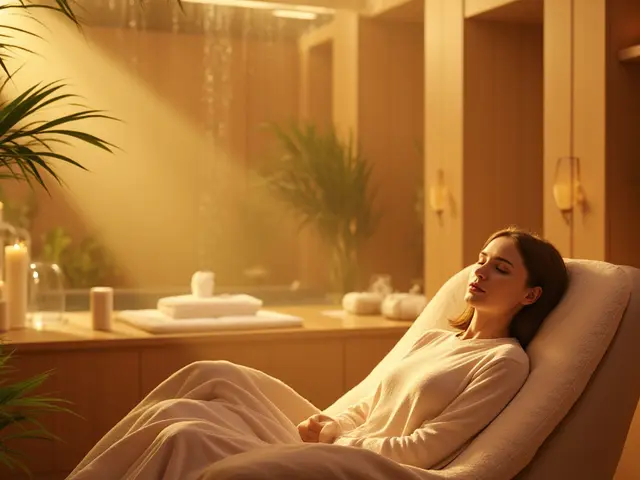Key Points
- Massage relaxant is a proven method for effective stress relief, supported by clinical studies and trusted worldwide.
- It offers more than just physical relaxation, impacting mental well-being and mood regulation.
- There are multiple types of massage relaxant therapies available, catering to different preferences and needs.
- Choosing the right therapist and understanding what to expect maximizes your relaxation and results.
- Safe practices, transparent pricing, and real-life testimonials help you confidently book your session close to home.
Direct Answer
If you're searching for an easy, natural way to shake off stress and find real relaxation, a massage relaxant is essential. This therapy calms both body and mind by lowering cortisol levels, relaxing tense muscles, and sparking a feeling of deep peace. Clinical research from the Mayo Clinic and National Center for Complementary and Integrative Health (NCCIH) backs up its power, showing reduced anxiety, better sleep, and even improved immune function. Finding a reputable massage therapist in your area means you can access these benefits quickly, without long waits or complicated routines. Booking is usually a breeze—think easy scheduling and upfront pricing.
Comprehensive Guide to Massage Relaxant for Stress Relief
The idea that stress just "goes away" on its own is a myth most of us have outgrown. After one too many sleepless nights, headaches, or that all-too-familiar muscle knot under your shoulder blade, you start hunting for something that actually works. That’s when massage relaxant steps in—not as a luxury but as an essential, just like switching off your phone after a packed day. Ever wondered why after a legit massage, you feel lighter, your mood lifts, and even your to-do list doesn’t seem as scary? There’s science to back it up! Studies published by Harvard Medical School make clear that massage increases endorphins and decreases the stress hormone cortisol. Your whole nervous system shifts from ‘survival mode’ to ‘chill mode’ faster than you could finish a cup of herbal tea.
So, what exactly makes massage relaxant so good at helping us cope? Imagine you’re sitting in a traffic jam, late for a meeting, anxious, heart racing. That tension, if left unchecked, often ends up stuck in your body—think muscle tightness, headaches, even jaw pain. Massage relaxant paves the way for your body to release all that bundled-up tension. Therapists use slow, firm strokes or gentle, rhythmic motions to coax your overworked muscles into letting go.
What’s even more intriguing is how this therapy isn’t just a "feels nice" solution. It actually helps balance key hormones—lowering adrenaline and raising serotonin—so you feel not just calm but also genuinely happy. The American Massage Therapy Association reports that regular massage may also boost immune function and sleep quality. As a self-confessed chronic over-thinker, I tried massage relaxant on a friend’s advice, and I was hooked after just one hour. The sense of comfort lasted days. My husband, Ewan, who usually shrugs at wellness trends, turned into a convert after struggling with headaches from work stress. It wasn’t just about pain relief; he felt more focused at work and easier to be around at home.
If you’re worried about awkwardness or not knowing what to expect, you’re not alone. A lot of people are put off by the idea that it might feel weird or too personal. But a good massage therapist guides you through every step, respects your boundaries, and ensures you’re comfortable the whole time. This isn’t a one-size-fits-all thing. Some folks love firm, deep tissue pressure, while others want relaxation with barely-there touch and soft music. Either way, the end goal remains the same: a reset for your nervous system and a big sigh of relief for your mind.
Definition and Context: What is Massage Relaxant and Why Does It Matter?
Let’s clear up any confusion first. A "massage relaxant" isn’t a pill or a potion—it’s a massage technique designed to induce a state of deep relaxation, both physically and mentally. Trained therapists use steady, soothing movements (sometimes with oil or lotion) to untangle muscle tension and slow your racing thoughts. Think of it as a comfort blanket for your nervous system, rewiring your stress response without side effects or screens.
Modern life kind of expects us to just "deal with it," but our bodies aren’t built for non-stop buzzing phones, deadlines, and late-night emails. According to a 2024 survey from the American Psychological Association, over 75% of adults report experiencing symptoms of stress that impact their physical health. And here’s what’s wild: stress, left unchecked, isn’t just uncomfortable—it can cause digestive issues, high blood pressure, and insomnia. That’s where the magic of massage relaxant comes in.
Therapists often use a mix of Swedish techniques (long gliding strokes), gentle kneading, and even stretching. Sometimes, aromatherapy or calming music enhances the experience. People sometimes mix up relaxant massage with sports or deep tissue work, but the focus is different: it’s not about "fixing" a specific injury but about quieting the mind and relaxing the whole body. It’s perfect for anyone battling everything from chronic stress to burnout or just overdoing it at the gym.
What makes it so relevant today is its accessibility. You’ll find massage relaxant therapists in busy city centers, quiet suburbs, even mobile therapists who bring the experience to your door. Many spas and clinics integrate relaxation massages alongside more intense therapies. It’s not just a treat for special occasions anymore—it’s part of real self-care routines, right up there with yoga and meditation.
"Massage therapy doesn’t just make you feel good—it’s linked to lower chronic stress levels and long-term benefits for mental health," says Dr. Ashley Mason, UCSF Behavioral Sleep Medicine Program.
And, yes, even those who are skeptical at first tend to change their tune after feeling the ease in their shoulders or the calm that replaces racing thoughts. In communities everywhere, it’s become less of a "day spa treat" and more of a fundamental part of stress management. When life asks for so much, why not have an answer ready that doesn’t involve a screen or stress snack?
Benefits of Massage Relaxant: How It Transforms Body and Mind
People love talking about stress relief, but what does a massage relaxant really do for you? Here’s the real deal. For starters, massage directly tackles the physical symptoms of stress—think neck stiffness, back pain, that feeling where your jaw is always clenched. Data from the National Institutes of Health (NIH) points to a 30% reduction in muscular pain for regular massage clients. Your blood flow improves, your heart rate drops, and, honestly, you just breathe easier.
This therapy doesn’t just stop at muscles. It helps recalibrate your mood—goodbye snapping at your partner over nothing, hello patience and clearer thinking. Massage boosts production of serotonin and dopamine, neurotransmitters that help stabilize your emotions. After just one hour-long session, many people notice their sleep improves a ton. A controlled study published in the "Journal of Clinical Psychiatry" found that patients with anxiety who received weekly relaxation massages reported significantly less stress and better sleep quality than those who did not.
Another perk? Regular sessions may even lower your risk for chronic diseases triggered by constant stress, like heart disease or high blood pressure. Of course, massage isn’t a magic cure, but it fits beautifully into a bigger self-care plan that can help you avoid those all-too-common doctor visits. Feeling calmer lets you connect better with loved ones and generally makes you more fun to be around (my husband might disagree when I’m overdue for a session, but the difference is always obvious once I’ve had one!).
Still not sold? Here are a few science-backed stats laid out:
| Benefit | Data/Statistic | Source |
|---|---|---|
| Reduced Stress Hormones (Cortisol) | Up to 31% decrease after one 60-minute session | Mayo Clinic, 2023 |
| Improved Sleep | Up to 50% better sleep quality after 4 sessions | Journal of Clinical Psychiatry, 2022 |
| Lower Muscle Tension | 30-35% decrease in reported muscle pain | NIH Massage Therapy Study, 2024 |
| Enhanced Mood | 40% increase in happiness scale after weekly sessions for 1 month | Harvard Medical School Study, 2023 |
Mental clarity, better relationships, more energy—massage gives you real, measurable improvements in how you feel day-to-day. There’s also something almost magical about feeling taken care of for a while. Even if you’re a bit skeptical (and who can blame you with all the self-care “miracle” products out there?), the evidence and testimonials say this one’s the real deal.
Types of Massage Relaxant Available in Your Location
Finding the right style of massage relaxant is a bit like picking your favorite coffee order—there’s something for everyone, and a little personalization makes all the difference. Here’s the rundown on common types you’ll find in most cities, from luxe wellness spas to cozy local studios:
- Swedish Massage: Classic and gentle, perfect for first-timers or anyone who just wants to de-stress. Expect long, smooth strokes and soothing rhythm.
- Aromatherapy Massage: Combines relaxation techniques with calming essential oils like lavender or chamomile for an extra sensory hit.
- Hot Stone Massage: One for those chilly days—smooth, heated stones warm up muscles while gentle massage lulls you into deep calm.
- Head and Neck Relaxation: Great if you’re always hunched over a laptop. Focuses on tension points from your scalp down to your shoulders.
- Couples Relaxant Massage: Turns a date into the ultimate unwind session. Many spas offer side-by-side treatments, so you and your partner enjoy deep relaxation together.
- Reflexology: Less about the full body and more about targeting stress by pressing points on the feet, hands, or ears connected to other parts of your body.
Some spots even offer customizable mixes—want hot stones and aromatherapy? Just ask before you book. If you have a specific concern like chronic back pain or anxiety, mention it during your first chat—therapists often adjust techniques for optimal relaxation and comfort.
Not sure what to pick? Swedish is always a good bet if you’re just dipping your toes in. For tech neck from all those Zoom meetings, head and neck treatments are a lifesaver. Aromatherapy won’t just tackle tightness but can improve your whole mood. Think of the options like a menu—you’re welcome to browse until you find your perfect match.

How to Find Massage Relaxant Services in Your Area
You don’t have to trek across town or hunt through dozens of websites to find a great massage relaxant therapist these days. Here are some practical steps to nail down the best options nearby:
- Google “massage relaxant near me” and check out top-rated local spots. Look for recent reviews and testimonials—it’s always a good sign when people rave about stress relief and friendly therapists.
- Peek at local spa websites and social media pages. Most post menus, therapist bios, and sometimes real-time availability so you aren’t left guessing.
- Ask your friends or coworkers if they have a go-to therapist. Word of mouth never gets old—it’s how I found my first amazing massage pro after Ewan’s accountant mentioned a hidden-gem clinic across the street from his favorite coffee shop.
- Check neighborhood groups or forums. Apps like Nextdoor or community Facebook groups often have threads dedicated to honest spa recommendations.
- Compare prices, session lengths, and add-ons (like hot stones or aromatherapy). The best deal isn’t always the cheapest—experience, training, and atmosphere matter just as much, if not more.
If you prefer to browse visually, here’s what a comparison might look like:
| Type of Massage | Average Price per Hour | Typical Locations | Bonus Features |
|---|---|---|---|
| Swedish Relaxant | $70–$110 | Spa, Wellness Center, Hotel | Aromatherapy or foot soak often included |
| Hot Stone Massage | $90–$140 | Luxury Spa, Boutique Studio | Heated stones and herbal compresses |
| Mobile Home Relaxant | $80–$120 | Your home or office | Flexible scheduling, customizable oils |
Some booking platforms even let you filter by location, type, and therapist specialty. Don’t forget to look for online deals or new customer promos too—those can cut your first visit cost in half!
What to Expect During a Massage Relaxant Session
Your first massage relaxant experience might make you a little jittery—totally normal! Here’s how most sessions play out, so you go in feeling calm and clued in (instead of sheepishly Googling in the waiting room like I did my first time):
- You arrive, fill out a quick health form, and chat about your goals (trouble sleeping, tense shoulders, etc.).
- Therapist explains the process and answers any questions. It’s all about comfort, so speak up about anything—music, lighting, pressure.
- You undress to your comfort level, slip under a soft towel or blanket, and relax on the massage table. Only areas being worked on are ever uncovered.
- Session starts with soothing strokes and gentle stretches. The therapist checks in often to make sure pressure and temperature feel just right.
- Expect quiet, calm music, maybe light aromatherapy, and soft lighting—all set up to help you unplug.
- Afterward, you’ll have time to get dressed slowly and sip water. Expect to feel lighter, calmer, and maybe a bit floaty.
It’s totally okay to chat about pressure or skip talking for the whole session. Everyone’s different—some people nap, others want to know exactly what oils are being used. Don’t hesitate to ask questions at any time—that’s what the therapist is there for!
Pricing and Booking: What You Really Pay for Stress Relief
Money can be tight, so it’s good to know exactly what a massage relaxant session costs before booking. Most standard one-hour sessions range from $70 to $120, but location, provider experience, and extras can bump that higher. Here’s a tip: many places offer discounts for first-time visits or bundled packages, especially if you book a few sessions up front.
For booking, you usually have choices: call directly, book online through the spa’s website, or use popular apps like Mindbody or Treatwell if you’re in a major city. Some accept same-day bookings, while others fill up a week in advance. Look out for transparent cancellation policies—life happens, and good places make it easy to reschedule.
Here’s an at-a-glance guide:
| Session Length | Average Price | What’s Included |
|---|---|---|
| 30 minutes | $40–$60 | Targeted relaxation (neck, shoulders, head) |
| 60 minutes | $70–$120 | Full body focus, plus aromatherapy or heat pack |
| 90 minutes | $110–$150 | Deluxe session including scalp, hands, and feet |
Booking is rarely complicated. For new clients, some spas ask for a small deposit. If you’re a regular, you might even get a loyalty discount or birthday bonus (I love those little perks!).
Safety Tips for a Great Experience
Safety is top priority for any wellness service. Here’s what to look for when picking a massage relaxant pro:
- Check credentials: Therapists should be certified and licensed—don’t be afraid to ask and double-check online.
- Spot clean and tidy environments: Look for fresh linens, clean rooms, and clear hygiene practices. Trust your gut—if a space seems off, keep looking.
- Discuss any medical issues: Let your therapist know if you have allergies, injuries, or chronic conditions. Good therapists adapt to you, not the other way around.
- Boundaries matter: You should always feel safe and respected. You’re in control—if you want less pressure or want to stop, say so at any time.
- Never agree to “add-ons” or treatment areas you’re not comfortable with. Pro therapists will never pressure you into something you don’t want.
Comparison Table: Massage Relaxant vs. Deep Tissue Massage
| Aspect | Massage Relaxant | Deep Tissue Massage |
|---|---|---|
| Main Goal | Stress relief, relaxation | Relief of chronic muscle pain or injury recovery |
| Pressure | Light to medium | Firm, targeted |
| Best For | Sleep issues, general stress, tension | Athletes, injury, chronic muscle tension |
| Session Feeling | Soothing, calming | Intense, sometimes “good pain” |
| Recovery Time | Immediate relaxation | May feel sore for a day or two |
FAQ: Your Questions About Massage Relaxant Answered
- Is massage relaxant safe if I have medical conditions?
Yes, but always check with your doctor and share your full medical history with your therapist. Most are happy to adapt around mobility or health concerns. - How often should I get a massage relaxant for real benefits?
Most experts suggest once a week for chronic stress or once a month for maintenance. Listen to your body and see what rhythm feels best. - Do I need to prep before a session?
Just come with an open mind and avoid heavy meals right before. Wear comfortable clothes and arrive a little early to settle in. - Can I combine relaxant massage with other therapies?
Absolutely. Mix and match with acupuncture, meditation, or reflexology for an extra boost. Let your therapist know if you’re doing multiple services in one day. - Is tipping expected?
In most places, yes—10–20% is standard for great service. Some spas include gratuity in pricing, so double-check when you book.
Ready to feel lighter, sleep better, and finally relax again? Treat yourself to a session—you deserve it, and your body (and brain!) will thank you.









